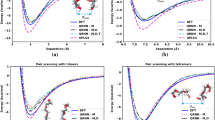Abstract
An artificial neural network (ANN) model for modeling and prediction of the steric hindrance parameter σ of polymers with three quantum chemical descriptors, the average polarizability of a molecule α, entropy S, and dipole moment μ, was developed. These descriptors were calculated from the monomers of the respective polymers according to the density functional theory at the B3LYP level of the theory with the 6-31G(d) basis set. Optimal conditions were obtained by adjusting various parameters by trial-and-error. Simulated with the final optimum BP neural network [3-1-1], the results show that the predicted σ values are in good agreement with the experimental ones, with the root mean square (rms) error being 0.080 (R = 0.945) for the training set, and 0.078 (R = 0.918) for the test set, which indicates that the proposed model has better predictive capability than the existing one.
Similar content being viewed by others
References
Becke, A. D. (1993). Density-functional thermochemistry III. The role of exact exchange. The Journal of Chemical Physics, 98, 5648–5652. DOI: 10.1063/1.464913.
Bicerano, J. (1996). Prediction of polymer properties (2nd ed.). New York: Marcelar Dekker.
Frisch, M. J., Trucks, G. W., Schlegel, H. B., Scuseria, G. E., Robb, M. A., Cheeseman, J. R., Montgomery,Jr., J. A., Vreven, T., Kudin, K. N., Burant, J. C., Millam, J. M., Iyengar, S. S., Tomasi, J., Barone, V., Mennucci, B., Cossi, M., Scalmani, G., Rega, N., Petersson, G. A., Nakatsuji, H., Hada, M., Ehara, M., Toyota, K., Fukuda, R., Hasegawa, J., Ishida, M., Nakajima, T., Honda, Y., Kitao, O., Nakai, H., Klene, M., Li, X., Knox, J. E., Hratchian, H. P., Cross, J. B., Bakken, V., Adamo, C., Jaramillo, J., Gomperts, R., Stratmann, R. E., Yazyev, O., Austin, A. J., Cammi, R., Pomelli, C., Ochterski, J. W., Ayala, P. Y., Morokuma, K., Voth, G. A., Salvador, P., Dannenberg, J. J., Zakrzewski, V. G., Dapprich, S., Daniels, A. D., Strain, M. C., Farkas, O., Malick, D. K., Rabuck, A. D., Raghavachari, K., Foresman, J. B., Ortiz, J. V., Cui, Q., Baboul, A. G., Clifford, S., Cioslowski, J., Stefanov, B. B., Liu, G., Liashenko, A., Piskorz, P., Komaromi, I., Martin, R. L., Fox, D. J., Keith, T., Al-Laham, M. A., Peng, C. Y., Nanayakkara, A., Challacombe, M., Gill, P. M. W., Johnson, B., Chen, W., Wong, M. W., Gonzalez, C., & Pople, J. A. (2003). Gaussian 03, Revision B. 05. Pittsburgh, PA: Gaussian Inc.
Karelson, M., Lobanov, V. S., & Katritzky, A. R. (1996). Quantum-chemical descriptors in QSAR/QSPR studies. Chemical Reviews, 96, 1027–1043. DOI: 10.1021/cr950202r.
Lee, C., Yang, W., & Parr, R. G. (1988). Development of the Colle-Salvetti correlation-energy formula into a functional of the electron density. Physical Review, B37, 785–789. DOI: 10.1103/PhysRevB.37.785.
Liu, W. Q., Yi, P. G., & Tang, Z. L. (2006). QSPR models for various properties of polymethacrylates based on quantum chemical descriptors. QSAR & Combinatorial Science, 25, 936–943. DOI: 10.1002/qsar.200510177.
Malík, I., Sedlarova, E., Csöllei, J., Andriamainty, F., & Čižmarik, J. (2007). Relationship between physicochemical properties, lipophilicity parameters, and local anesthetic activity of dibasic esters of phenylcarbamic acid. Chemical Papers, 61, 206–213. DOI: 10.2478/s11696-007-0021-8.
Parr, R. G., & Wang, W. (1994) Density-functional theory of atoms and molecules, p. 352. New York: Oxford University Press.
Parr, R. G., & Wang, W. (1995). Density-functional theory of the electronic structure of the molecules. Annual Review of Physical Chemistry, 46, 701–728. DOI: 10.1146/annurev.pc.46.100195.003413.
Tang, Q. Y., & Feng, M. G. (2002). Practical statistics and DPS data processing system. Beijing: Science.
Wang, Z., & Wu, S. (2007). Binding affinities and spectra of complexes formed by dehydrotetrapyrido[20]annulene and small molecules. Chemical Papers, 61, 313–320. DOI: 10.2478/s11696-007-0039-y.
Yu, X. L., Yi, B., Wang, X. Y., & Xie, Z. M. (2007a). Correlation between the glass transition temperatures and multipole moments for polymers. Chemical Physics, 332, 115–118. DOI: 10.1016/j.chemphys.2006.11.029.
Yu, X. L., Yi, B., Xie, Z. M., Wang, X. Y., & Liu, F. (2007b). Prediction of the conformational property for polymers using quantum chemical descriptors. Chemometrics and Intelligent Laboratory Systems, 87, 247–251. DOI: 10.1016/j.chemolab.2007.03.001.
Yu, X. L., Xie, Z. M., Yi, B., Wang, X. Y., & Liu, F. (2007c). Prediction of the thermal decomposition property of polymers using quantum chemical descriptors. European Polymer Journal, 43, 818–823. DOI: 10.1016/j.eurpolymj.2006.12.031.
Yu, X. L., Yi, B., & Wang, X.Y. (2007d). Prediction of refractive index of vinyl polymers by using density functional theory. Journal of Computational Chemistry, 28, 2336–2341. DOI: 10.1002/jcc.20752.
Yu, X. L., Yi, B., Yu, W. H., & Wang, X. Y. (2008a). DFT-based quantum theory QSPR studies of molar heat capacity and molar polarization of vinyl polymers. Chemical Papers, 62, 623–629. DOI: 10.2478/s11696-008-0066-3.
Yu, X. L., Liu, W. Q., Liu, F., & Wang, X. Y. (2008b). DFT-based theoretical QSPR models of Q-e parameters for the prediction of reactivity in free-radical copolymerizations. Journal of Molecular Modelling, 14, 1065–1070. DOI: 10.1007/s00894-008-0339-3.
Yu, X. L., Yi, B., Liu, F., & Wang, X. Y. (2008c). Prediction of the dielectric dissipation factor tan δ of polymers with an ANN model based on the DFT calculation. Reactive and Functional Polymers, 68, 1557–1562. DOI:10.1016/j.reactfunctpolym.2008.08.009.
Author information
Authors and Affiliations
Corresponding author
Rights and permissions
About this article
Cite this article
Yu, X., Yu, W., Yi, B. et al. Artificial neural network prediction of steric hindrance parameter of polymers. Chem. Pap. 63, 432–437 (2009). https://doi.org/10.2478/s11696-009-0036-4
Received:
Revised:
Accepted:
Published:
Issue Date:
DOI: https://doi.org/10.2478/s11696-009-0036-4



